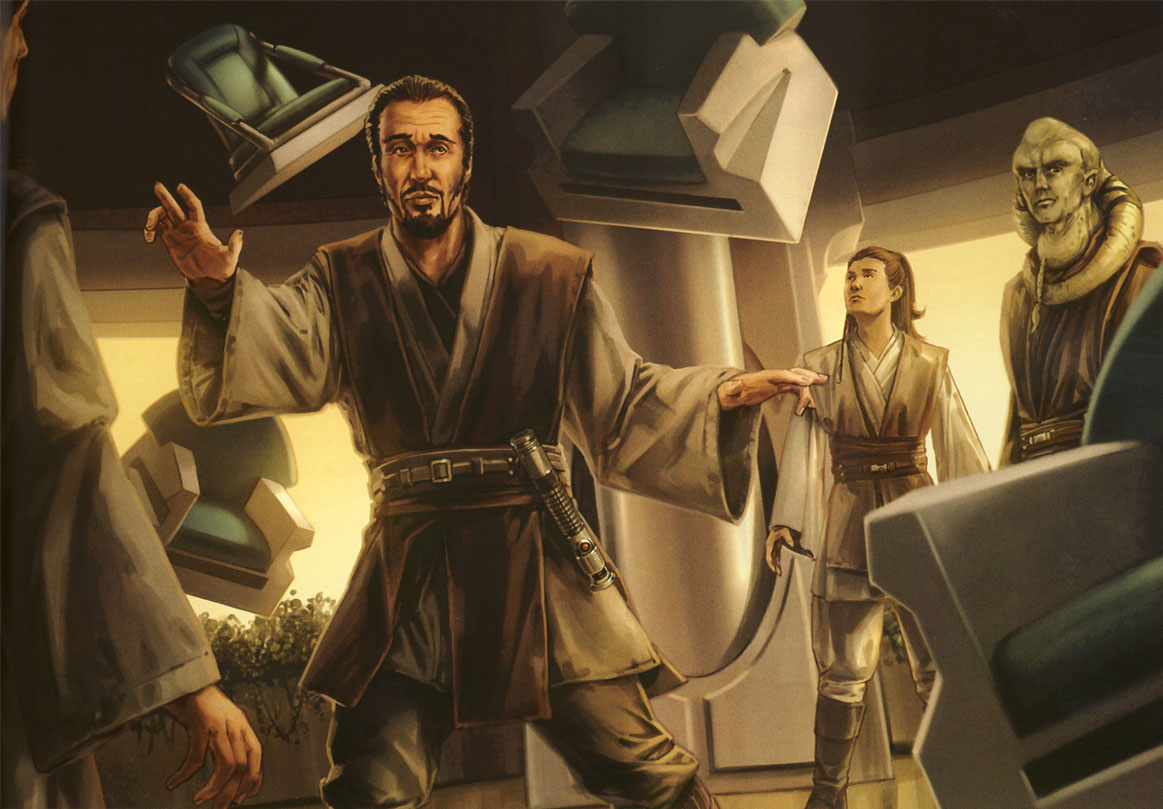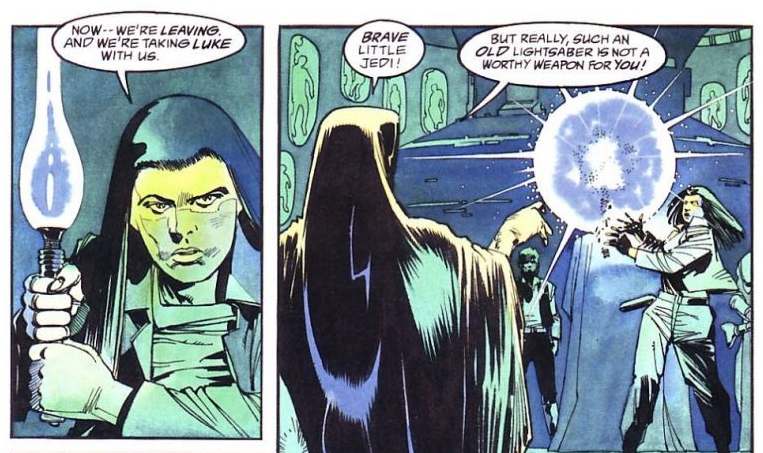Telekinesis, often shortened to TK, represented a neutral ability found in most Force-sensitive beings. This power allowed individuals to move and control physical objects in diverse ways, all through the power of the Force. While virtually every Force-sensitive individual and organization possessed this ability, the specific techniques used could vary significantly. Telekinesis offered a wide array of applications, spanning both combat and practical uses.
The main function of telekinetic abilities was to manipulate physical matter, enabling the user to touch, seize, hold, and otherwise interact with a target. Force-users could employ this ability to push, pull, and lift objects. It could also serve as a means to disarm or physically assault opponents, as well as provide defense for the user or the target. A sufficiently skilled or powerful practitioner could overcome limitations related to size, distance, weight, and mass. For example, one could lift a small piece of fruit or an X-Wing, or affect a target from another room or even several light-years away by observing them through a holocomm or viewscreen, provided they maintained physical awareness of the target's location.
Telekinesis also involved exerting and resisting physical forces from a distance without physical contact. The strength and intensity of this force could manifest in various ways, from gently levitating small to medium-sized objects to slowing or completely stopping moving targets. It could even crush targets with the force of metal under extreme pressure. This manipulation of force could also generate shockwaves, vibrations, and even seismic energy, as well as concussive or explosive force, which could be used to repel, damage, or destroy targets. Furthermore, telekinesis could utilize air manipulation by controlling air pressure, currents, and pockets. This enabled users to perform feats like creating explosive bursts of force or powerful winds. Beyond offensive applications, telekinesis could create an invisible field or barrier of physical force with varying sizes, shapes, and intensities for defense. Many of these abilities could manifest directly from or around the user's body.
Although telekinesis allowed users to manipulate and interact with targets from a variable distance without physical contact, its precision, accuracy, magnitude, range, and intensity depended on the user's concentration, willpower, emotions, senses, and spatial awareness. Consequently, a user's power could weaken, leading to an inability to properly control it. Physical or mental fatigue, stress, or disorientation would often nullify the use of such an ability for most users.
Despite the numerous potential applications of telekinesis, the power often induced physical and mental stress and exhaustion, especially when used on objects larger or heavier than the user or those already subjected to significant force, such as falling objects or moving vehicles. The size, weight, and distance of a target could also influence the ease and speed with which it could be moved. Because the target was influenced by the user's concentration and conscious effort, most Force-users were typically unable to focus their abilities on multiple targets for extended periods and relied on their physical senses, such as sight and hearing, to lock onto their target. Exhausting or stressing their powers or themselves, physically or mentally, would require users to recover their composure before resuming proper use of their abilities. Furthermore, Force users actively employing telekinesis were often unable to perform other tasks, including movement in extreme cases, as they had to devote most of their concentration and effort to the specific task. This could leave them vulnerable in dangerous situations like open combat, where interruption could cause them to lose control of their target. Such limitations regularly hampered or restricted the ability's use, particularly in combat, leading Force users to resort to physical combat, often with a lightsaber. Alternatively, intense emotions such as stress, anger, hate, fear, and desperation could enhance a user's telekinetic strength, reducing the effort required to maintain control of a targeted object or enabling them to apply abnormally precise or extreme force beyond their natural limits.
The ability is often expressed through bodily gestures, specifically movements of the eyes, hands, fingers, or sometimes the entire body. These gestures represent the most common method of using the power, particularly when the user's mind or senses are strained or overwhelmed, as they require less concentration, focus, and effort to manifest their ability. However, this reliance on gestures can limit the use of one's abilities if the user is restrained or otherwise immobilized.
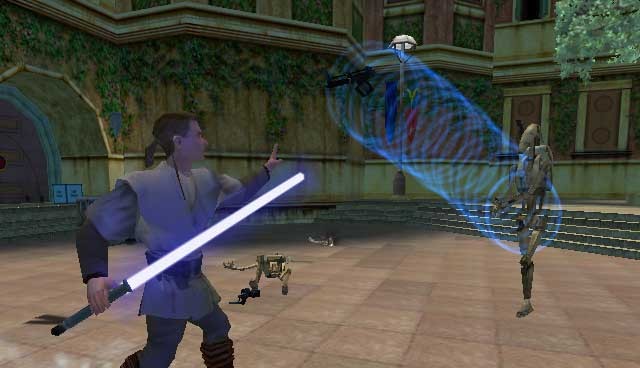
The fundamental application of telekinesis involved extending one's feelings and will through the Force to physically grasp a targeted object or objects, exerting one's will to manipulate its actions. This Force power operated on the principle that the Force responds to a Force-user's strength of will, enabling them to apply the Force with their mind to another space or object. While this technique allowed the user to exert force on a target as if they were physically interacting with it, it primarily served to suspend existing forces, such as gravity, enabling the user to levitate a target, defying its weight, or to attract and repel an object similar to magnetic or gravitational force. Savage Opress successfully halted a knife thrown by Sugi just before it reached the head of Darth Maul during a mission. However, in its most basic form, this ability was only sufficient to cause an object to hover and float, lacking the precision or accuracy for further control, and the applied force was insufficient to push, drag, or directly damage the object. Additionally, instances of intense focus, such as during meditation, could unintentionally cause surrounding objects to levitate, potentially leading to objects orbiting each other and the user.
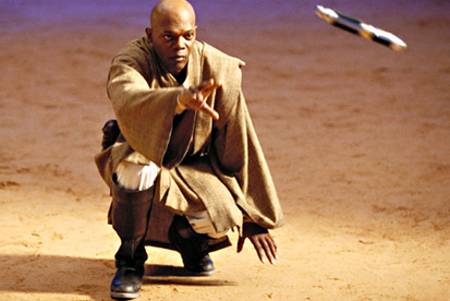
This telekinetic ability, powered by the Force, could draw a physical object closer to the user. The user's proficiency determined the weight of the object that could be pulled or the breadth of the Force "wave." It could be used to retrieve weapons from enemies or, at higher skill levels, to draw enemies themselves within range of a Jedi's lightsaber. This power proved especially useful when a chasm or hole separated the caster and the opponent. It could also be used to pull foes to the ground. One of the most impressive applications of this ability involved pulling a starship from the sky. In 3641 BBY, Khem Val claimed that Tulak Hord once pulled a ship the size of the Endar Spire onto a planet's surface. In 2 BBY, Galen Marek demonstrated this ability on Raxus Prime. Despite his uncertainty, he managed, with great effort, to use the Force on an already-falling Imperial I-class Star Destroyer, redirecting it to crash into an Imperial ore facility.
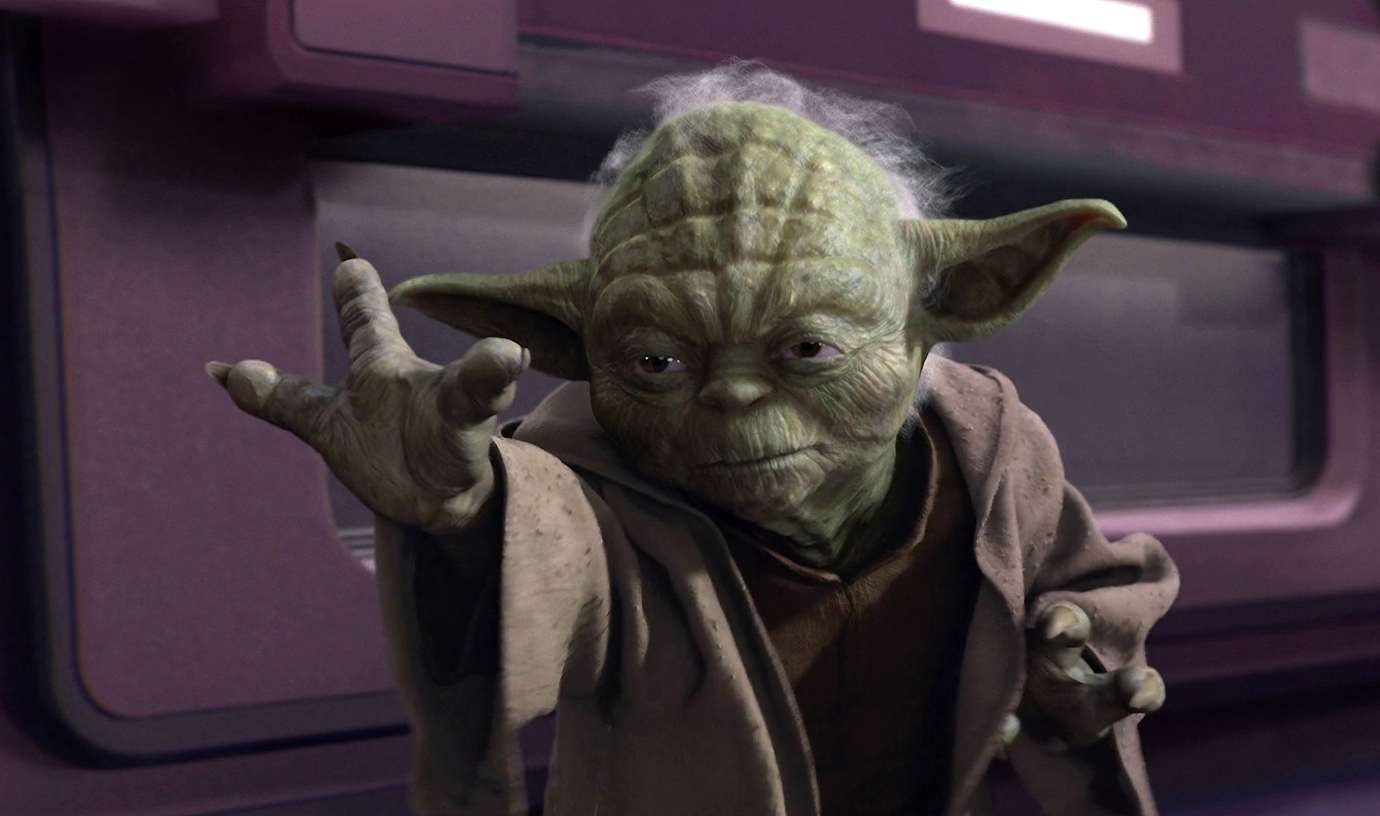
The most basic applications of Force Push employed telekinetically-derived force to propel objects away from the user. The effect could range from gently nudging or moving targets away to shoving and staggering them, knocking them backward or to the ground, or sending them flying through the air. Serving as both an offensive and defensive technique, this ability was commonly used by Force users to repel opponents or clear obstacles.
At higher levels, Force Push could manifest as a telekinetic impulse created with the Force, generating a concussive burst of pressurized air, similar to an explosive force, emanating from the user's body and impacting the target like a projectile. Depending on the user's power and skill, this ability could be used to shove or stagger a target or even shatter stone. The greater the user's telekinetic aptitude, the larger the pressure differential, and thus the stronger the effect and the heavier the target. With practice, a skilled Force user could increase the range and arc of the blast without reducing the average kinetic energy, creating a sweeping wave instead of a focused pulse. Highly skilled practitioners could generate a concussive blast radiating outward for dozens of meters in all directions, detonating with the physical force of a conventional explosive. Starkiller, under the influence of Force rage, could release a blast powerful enough to disintegrate Force-insensitive foes.

This technique proved effective for maintaining distance from enemies. Force users could employ a well-timed Force Push to send enemies tumbling off balconies or into deep chasms. Exceptionally skilled or powerful Force users could even kill opponents with the sheer force of the Push itself. Both Darth Vader and Galen Marek demonstrated this ability on numerous occasions. Beyond offense, this power had many practical applications, such as removing or pulverizing heavy debris and other obstructions too large to move without specialized equipment. Alternatively, Force Push could be used in a less directly damaging manner, with a burst of telekinetic energy deflecting large projectiles such as rockets harmlessly.
A trained Force user could resist a Force Push, presumably by shielding themselves with their own telekinetic energy. However, an opponent with sufficient skill or power could penetrate or overwhelm this shielding. Alternatively, depending on the user's level of power and skill, beings with sufficient physical strength and resilience could potentially withstand the full force of a Force Push.
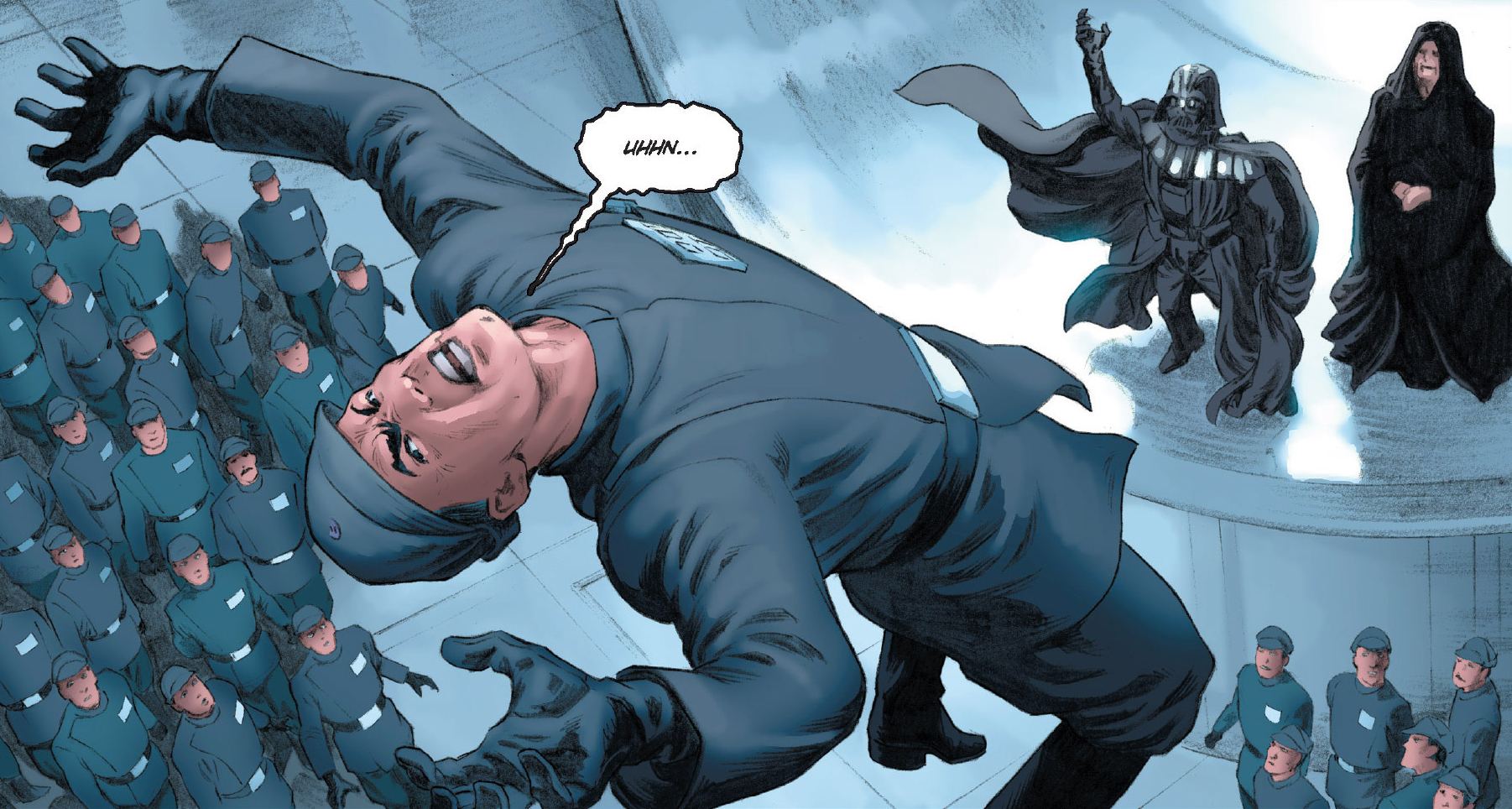
This highly versatile and adaptable use of telekinesis involved physically gripping a target, or a specific part of it, to exert more direct control beyond simple levitation. It was often used against enemies to restrain or immobilize them, lift and hold them in the air, forcibly control their movements, or, at a high enough degree, apply damaging pressure that could crush bones and organs or inflict other injuries.
This ability could negate a target's motion, not only reducing its speed but also completely halting and suspending it in place. In its most common form, the target could be seized with great strength, lifted off the ground, and suspended in the air. Due to its potential for harm and its focus on controlling and dominating a target, Force Grip and its variations are often considered dark side techniques. However, a Jedi could use it to peacefully and harmlessly immobilize an opponent, allowing the ability to be used without accessing the dark side or using emotions associated with it.
The grip was commonly applied not simply to levitate targets but to exert physical force, simulating physical contact. This allowed the user to grasp, squeeze, or constrict a specific part of their victim, such as the neck, or exert equal pressure on the entire body to better restrain and incapacitate them. More powerful users could even lift the target off the ground by their neck. The technique is often synonymous with Force Choke, but the primary difference lies in the choke's specific focus on the neck, or even more specifically, the throat or trachea, to restrict air and blood flow. The grip, on the other hand, could target multiple body parts simultaneously and be used to pin or slam targets into walls or ceilings, throw them great distances, or bring them over a fall or towards the user for a close-range attack. However, these techniques often coincided, as a user could telekinetically grab, hold, or lift their target by the neck with or without choking or strangling them.
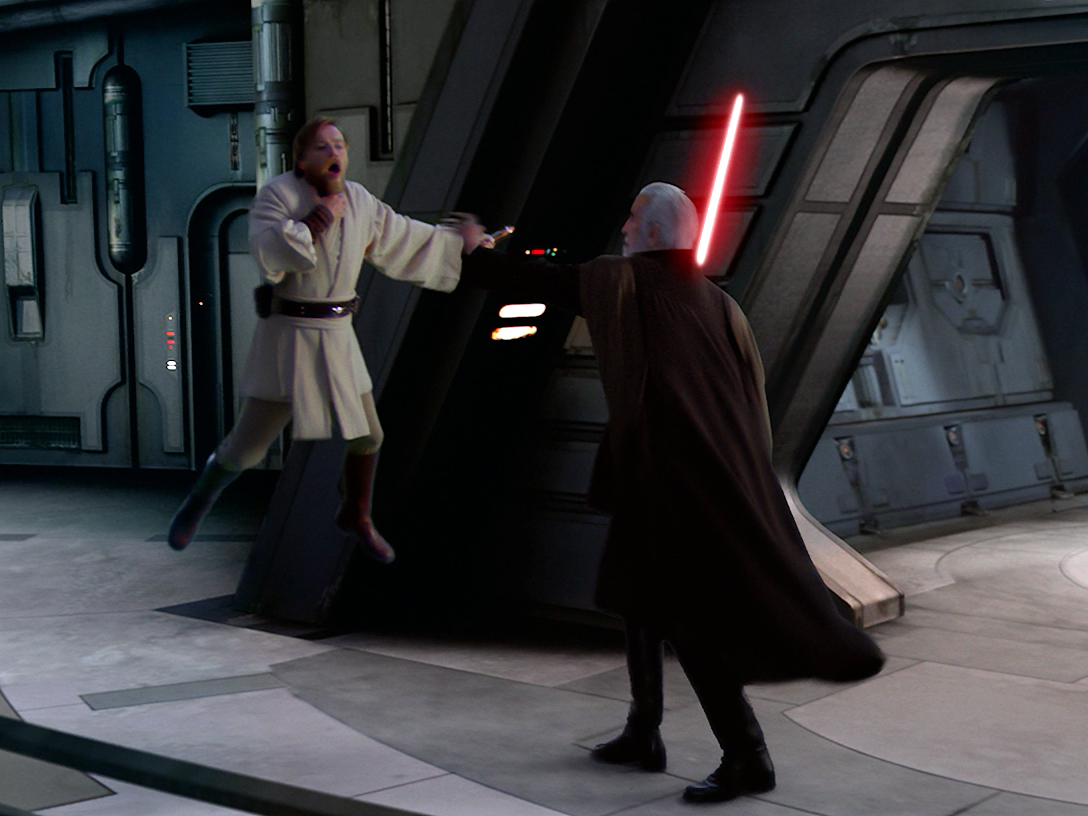
Some exploited this provision to escape the Grip's clutches; Jedi could use Force Persuasion or Force blinding to obscure the Grip-user's vision, or leap to escape it (with varying success, depending on the user's knowledge of the Force). Boba Fett was known to escape a Force Grip by firing his jetpack, using the propulsion to fly out of the Grip-user's line of sight.
If escaping the Grip-user's sight was impossible, disrupting their concentration was the next best option. Jedi during the New Republic could commonly do this by pushing their enemy with the Force, and others broke a Grip by blasting the user with a weapon. These solutions were limited, however; those most powerful in the technique could maintain concentration during a Force Push, and even more could control the Grip so well that the choked target could not even draw their weapon. A skilled user would not limit themselves to the grip, instead taking the opportunity to move an opponent over a fall, throw them, slam them into a wall, or force them to disable their lightsaber, then follow with an attack.
However, those most experienced and skilled with Force Grip could apply it without directly seeing their target or even being in their immediate vicinity, as long as they knew their target's location relative to themselves. Often, sufficiently skilled and powerful Force users could apply the technique while viewing their target through a viewscreen or hologram.
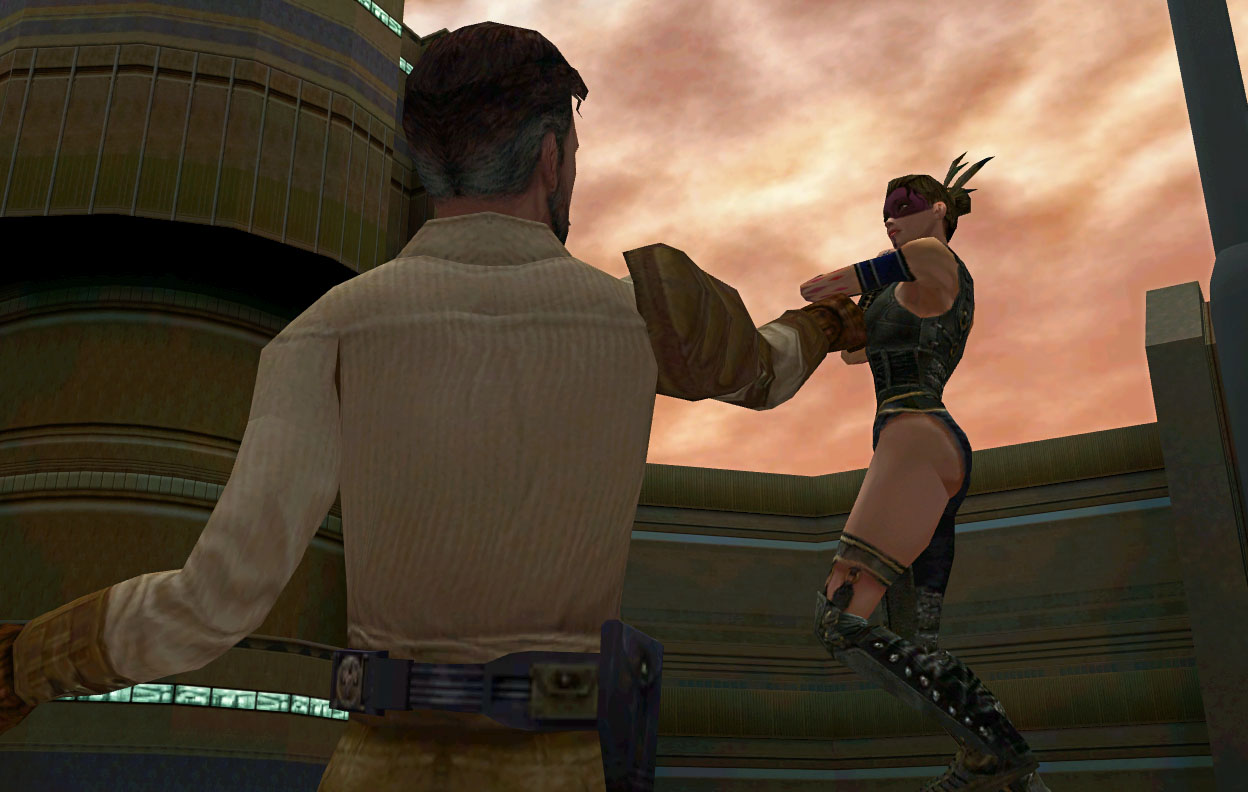
Force users known to have used this power included Count Dooku, who used it on Obi-Wan Kenobi when Obi-Wan and Anakin Skywalker boarded General Grievous's flagship to rescue Supreme Chancellor Palpatine; and Desann, who used the power at least once on Kyle Katarn. Dooku, in particular, demonstrated the use of the technique to forcibly manipulate the motor functions of others, such as when he Force choked Turk Falso while simultaneously forcing the pirate to draw his blaster and shoot his comrade. He performed a similar feat when he made Padmé Amidala aim at and shoot Bec Lawise. Additionally, Grandmaster Yoda used the technique to freeze his former apprentice's Sith assassin, Asajj Ventress in place as she was attempting to strike down King Katuunko on Toydaria before throwing her aside.
Kyle Katarn himself used this very Force power, first exercising a degree of control over Force Grip during the Reborn crisis, against Tavion Axmis, who had enraged Katarn by her involvement in his partner's apparent death. Though Katarn released Axmis once she revealed that the supposed killing was a ruse, and though he would quiet his anger from that moment forth, Katarn would continue to demonstrate the power through the rest of his days. Darth Vader's apprentice, Galen Marek, was also extremely competent with Grip and employed it as one of his primary weapons. Anakin Skywalker was seen using it in his duel with Barriss Offee at the Jedi Temple, preventing her from attacking and ending the duel. When he became Vader, he would routinely utilize it against fellow Force users, and developed his skill with it to the point that he could grip and throw even Starkiller with it.
Rend was a dark power that allowed the practitioner to move a single target, be it creature or object, in two different directions simultaneously, potentially tearing the target apart or otherwise damaging it.
Force Disarm used the Force to pull a weapon from an opponent's grasp. The Force-user could then choose to have the weapon fly into his hand. Yoda used Force Disarm to disarm Asajj Ventress when she tried to assassinate Toydarian King Katuunko, though it is noted that due to Yoda's greater power in the Force, he would have been able to overwhelm any attempts of Ventress to resist his power with her own. Prior to the Occupation of Bespin, Darth Vader used this power to disarm Han Solo as part of the capture of Solo and his companions by Imperial forces. Starkiller had employed force disarm against riot troopers by taking their weapons and using it as a weapon.
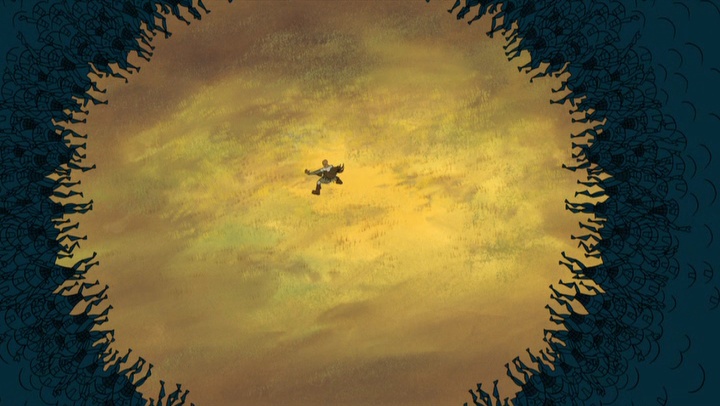
One of the most powerful forms of Force Push, it was essentially a wave of pure Force energy that pulsed out from the Force user that utilized it which knocked back anything within the power's blast radius. The strength of Force Wave was extremely potent, and its raw power was on more than one occasion described as a telekinetic explosion. It was more widespread, like a wave, hence the name, and could push multiple opponents at once. It was very useful in tight, cramped quarters when the Force user needed room to move, since Force users could damage their opponents by pushing them into the walls. It could also be used as "crowd control," when overwhelming numbers of enemies immediately swarm toward the user. Using Force Wave could be used to give the Force user time to rethink their strategy and cast more Force powers, or they could also attack fallen opponents as they are stunned. The technique was almost completely synonymous with Force Shockwave.
Mace Windu and Yoda used this power against B2 super battle droids during the Battle of Coruscant. Mace also used this power when he lost his lightsaber on Dantooine in the Clone Wars. This power was also used by Darth Bane against his former lightsaber instructor on Lehon to bring part of the Temple of the Ancients down on him, killing him. Darth Plagueis was powerful enough to use a Force Wave to nearly atomize six Maladian assassins' after being seriously injured in a surprise attack. Darth Vader was also capable of utilizing this ability, showcasing his skill during the Gentis Coup when he used one to kill dozens of Gentis's soldiers simultaneously. Luke Skywalker also used this move during his Duel with Darth Caedus. The most powerful known user of this ability was the dark-side entity Abeloth, who once produced a wave so powerful that it destroyed the city of Tahv, disintegrating nearby beings and materials and causing objects further away to combust.
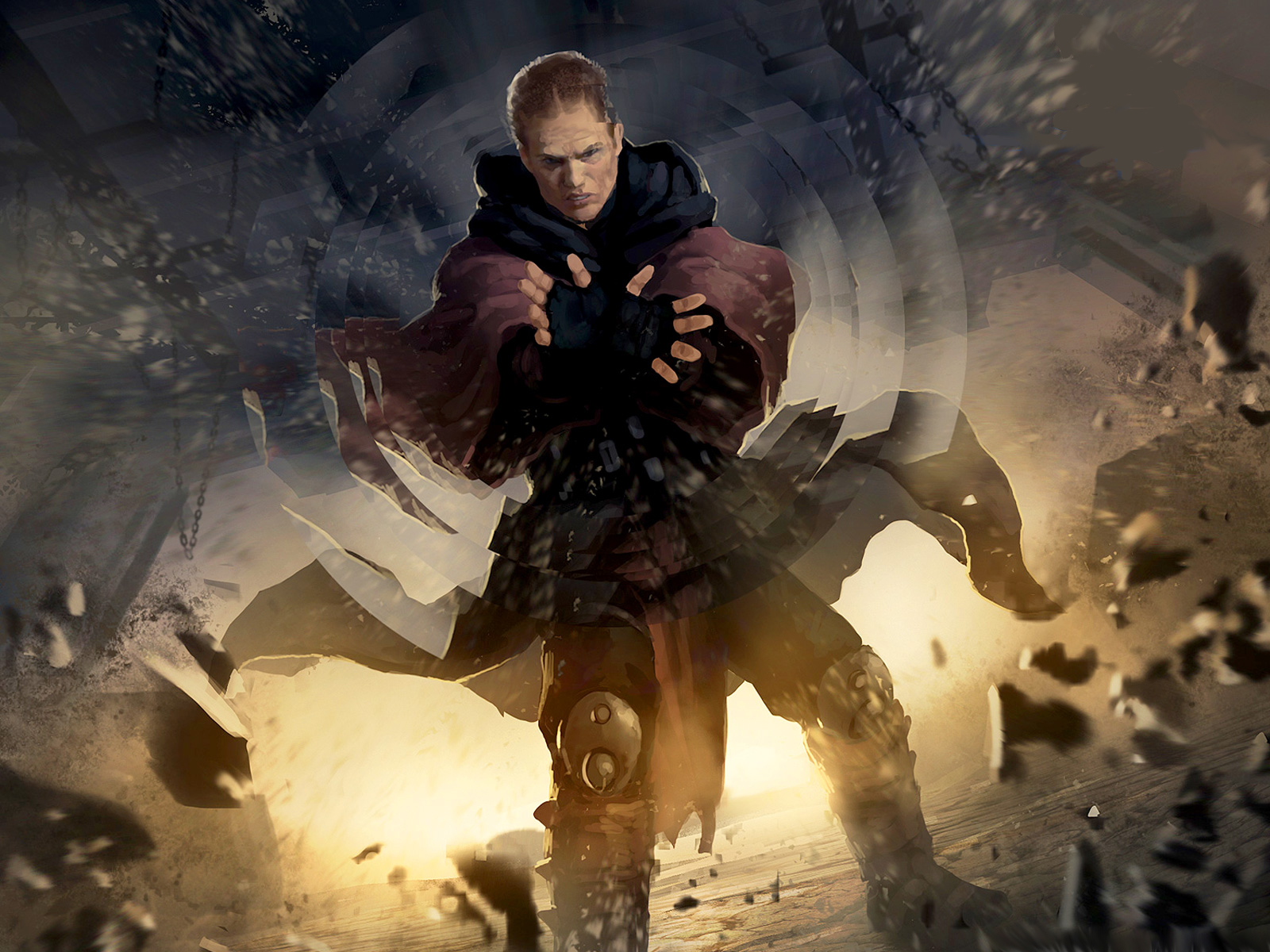
Force Shockwave, also known as Focus Shockwave or Force Bomb, was a Force power that allowed a Force-user to emit a powerful destructive ring of energy, damaging or destroying anything in its radius. The Jedi Master Obi-Wan Kenobi was a practitioner of this technique during the Clone Wars. Savage Opress also released a similar massive Force pulse against large group of battle droids, eliminating all of them and knocking Anakin Skywalker and Kenobi aside.
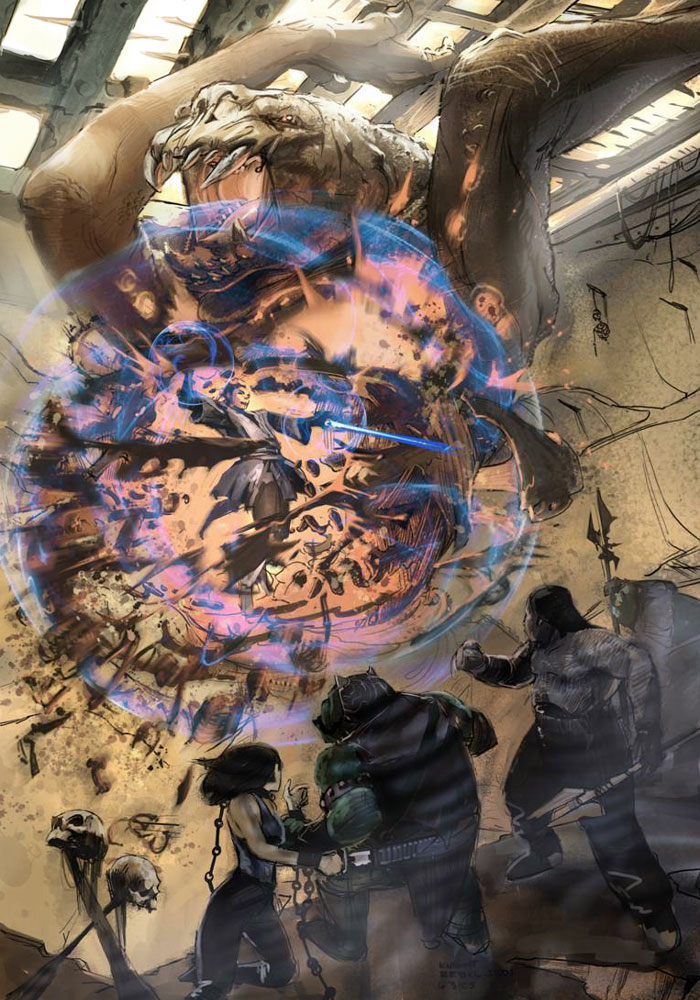
An extremely powerful telekinetic Force power similar in function to Force Push, and perhaps even more to Force Blow, but on a far larger scale, akin to that of Force Wave, Force Repulse was no more or less than a gigantic telekinetic explosion. The user would concentrate on the Force and violently push it outwards, creating rapidly-expanding kinetic ripples in space, flinging nearby objects away at high velocity. The power only affected objects a certain distance away from the user, and therefore could be avoided by moving further away from the user. The primary difference between it and the Force Wave ability appeared to be that a Repulse always functioned as a spherical explosion that radiated from the user, while a Force Wave typically functioned in a circular or hemi-circular fashion. Darth Vader was a master of this ability, as were his apprentices, Galen Marek and Starkiller. Obi-Wan Kenobi also utilized it during the Battle of Muunilinst against the bounty hunter Durge, causing an explosion of Force energy that blew the Gen'Dai apart from within. Similar abilities to this were Force Shockwave and the dark side technique of Force Destruction. In addition, a more powerful technique of this was Force Maelstrom, which combined a telekinetic explosive field with a Protection bubble and the dark side ability of Force Lightning to cause nearby objects to orbit the field and then be shot out in all directions in a forceful blast charged with Force Lightning.
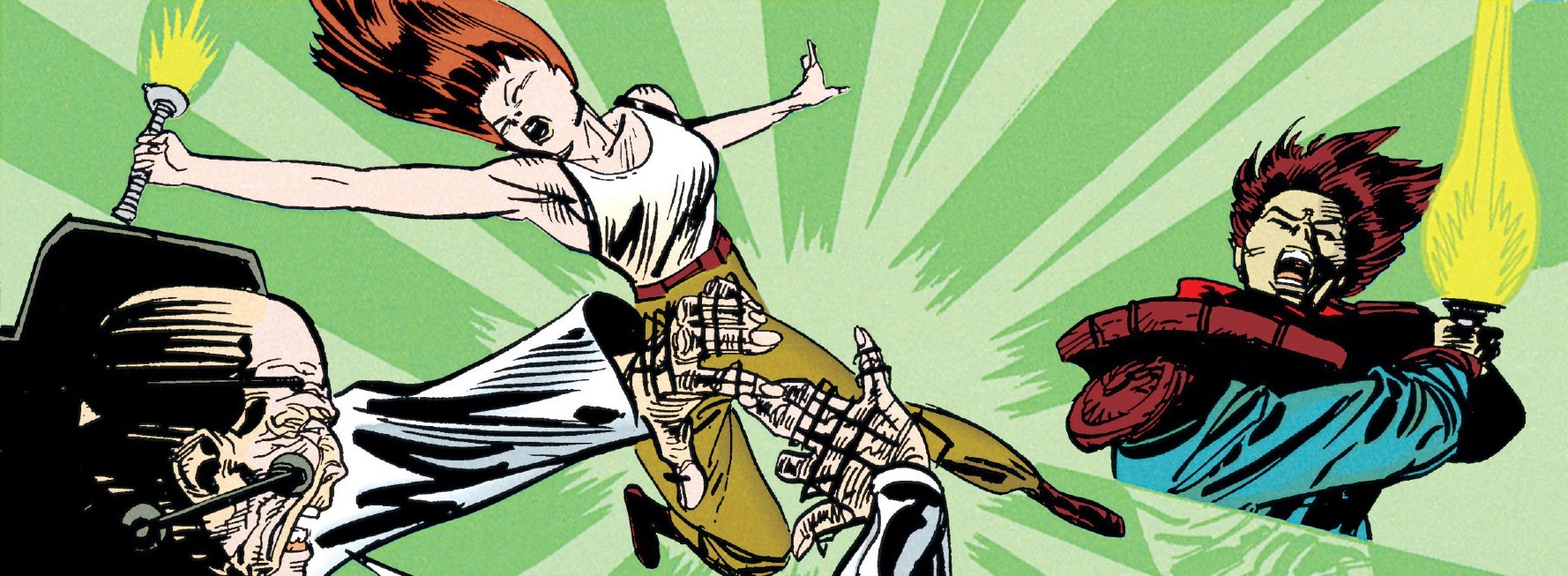
Force Blast was a powerful telekinetic exertion of the Force that was basically a more powerful version of Force Push, where the user would (hence its name) blast opponents and obstacles out of the way in a much more violent manner than a simple push. Galen Marek was a notable user of this ability. Darth Vader was also capable of using this power, as demonstrated during the Battle of Kamino when he used the technique to shatter Starkiller's lightsabers.

A focused sphere of Force energy, Force Burst was projected towards a target with extreme precision and velocity. The power behind the Burst was directly related to the time and energy invested in its creation. The size and power of a Burst could vary greatly, from immense and explosive to compact and lethal. Typically, it appeared as a semi-transparent sphere with a blue or green tint, whereas the Sith version displayed a reddish hue. Though similar in nature to Force Destruction, this ability wasn't exclusive to users of the dark side.
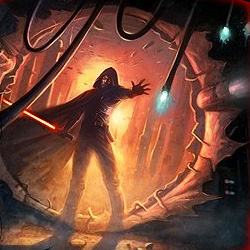
Force Destruction involved the creation of a substantial energy field, often shaped like a sphere, capable of covering a wide area. This field could paralyze or even obliterate beings caught within its radius. It was fueled by dark side energy accumulated and stored within the user's body, typically released through the arm or hand. Even those who avoided direct contact with the blast would be violently thrown back by the resulting shockwave. However, due to the significant effort and concentration required to use it even sparingly, this ability was quite taxing and therefore unreliable as a primary attack strategy. Noteworthy users of this power included the Inquisitor Jerec, Darth Bane, and Galen Marek.
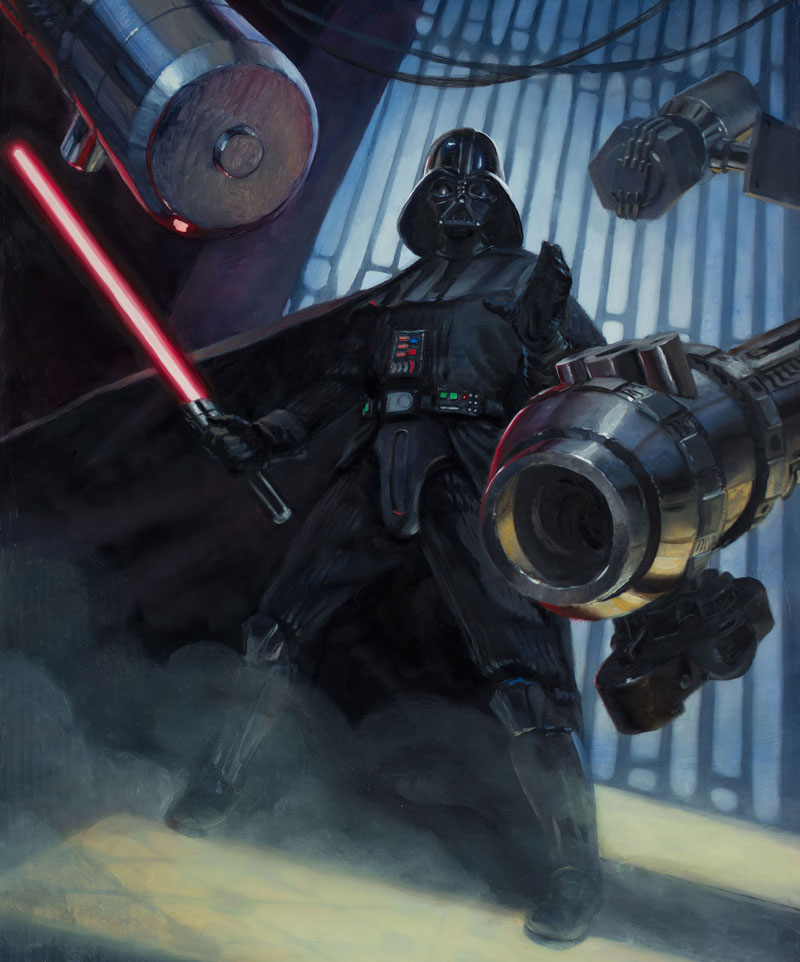
This technique, a fusion of Force Push and Force Grip, allowed the user to launch objects, including living beings, towards a designated target or area with incredible speed. Highly skilled Force wielders could simultaneously propel multiple large objects at high velocities, as demonstrated by Palpatine during his duel with Yoda in the Grand Convocation Chamber of the Senate Building, where he hurled repulsorpods at the Jedi Master. Anakin Skywalker employed this ability when under attack on Geonosis, flinging droideka arms at approaching Geonosian warriors. As Darth Vader, he utilized it to defeat Jedi Knight Roan Shryne in combat on Kashyyyk. Later, he used it to overpower and subdue his son, Luke Skywalker, during their confrontation in Cloud City on Bespin.
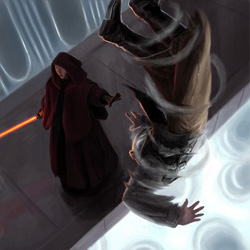
Serving as an enhanced version of Force Push, yet a weaker iteration of Force Wave, Force Whirlwind involved manipulating air currents around an adversary to create a swirling vortex. This vortex would lift the target into the air, spinning them uncontrollably and preventing them from escaping its grasp. This left the victim vulnerable to attack. A prominent example of its use was by Jacen Solo during his confrontation with Tsavong Lah on Duro. Jedi Masters Streen and Teneniel Djo displayed a natural aptitude for this ability, as did Plo Koon, who further refined it with his unique insights. Darth Malak employed this technique during his battle with Revan aboard the Leviathan. The former Dark Lord of the Sith, as well as the Ho'Din Jedi Master Plett, may have also possessed knowledge of this ability. The Witches of Dathomir knew this ability as the 'Spell of Storm'. It is possible that Meetra Surik and her companions also utilized this Force power during their mission to save the galaxy.
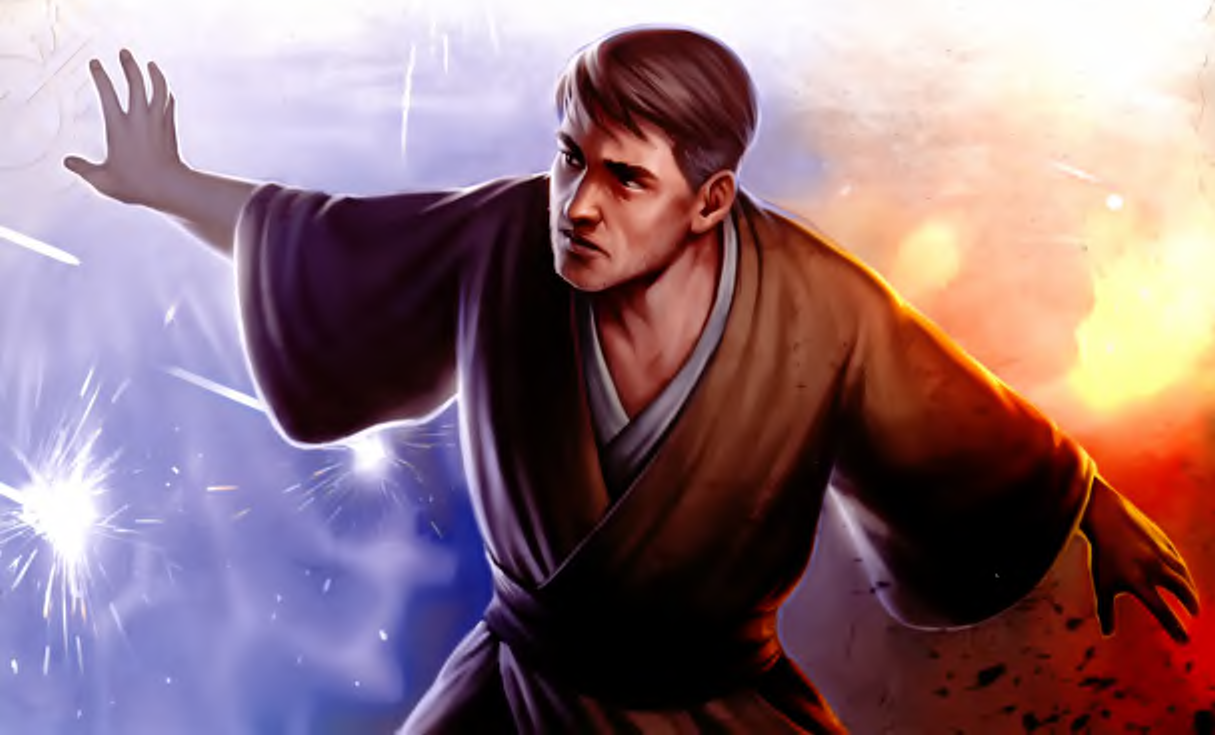
The Force Barrier served as both a defensive and offensive technique, enabling the user to generate a wall or barrier of Force energy around a chosen target, whether it be themselves, an ally, or an enemy. This barrier could provide protection against both physical objects and energy attacks, with a sufficiently strong barrier even capable of withstanding sonic assaults. Obi-Wan Kenobi employed this technique when targeted by a bounty hunter wielding a sonic boom grenade launcher. However, the barrier's strength could diminish over time due to continuous bombardment and the user's own fatigue.
Valenthyne Farfalla demonstrated this by briefly encasing Darth Bane within a Force Barrier, halting his attacks by accumulating energy into a barrier and a focused burst, until Bane broke free and the shield shattered into energy fragments. Similar techniques to Force Barrier include the Adiabatic shield, Protection bubble, Tutaminis, Force deflection, Energy resistance, and Force resistance.
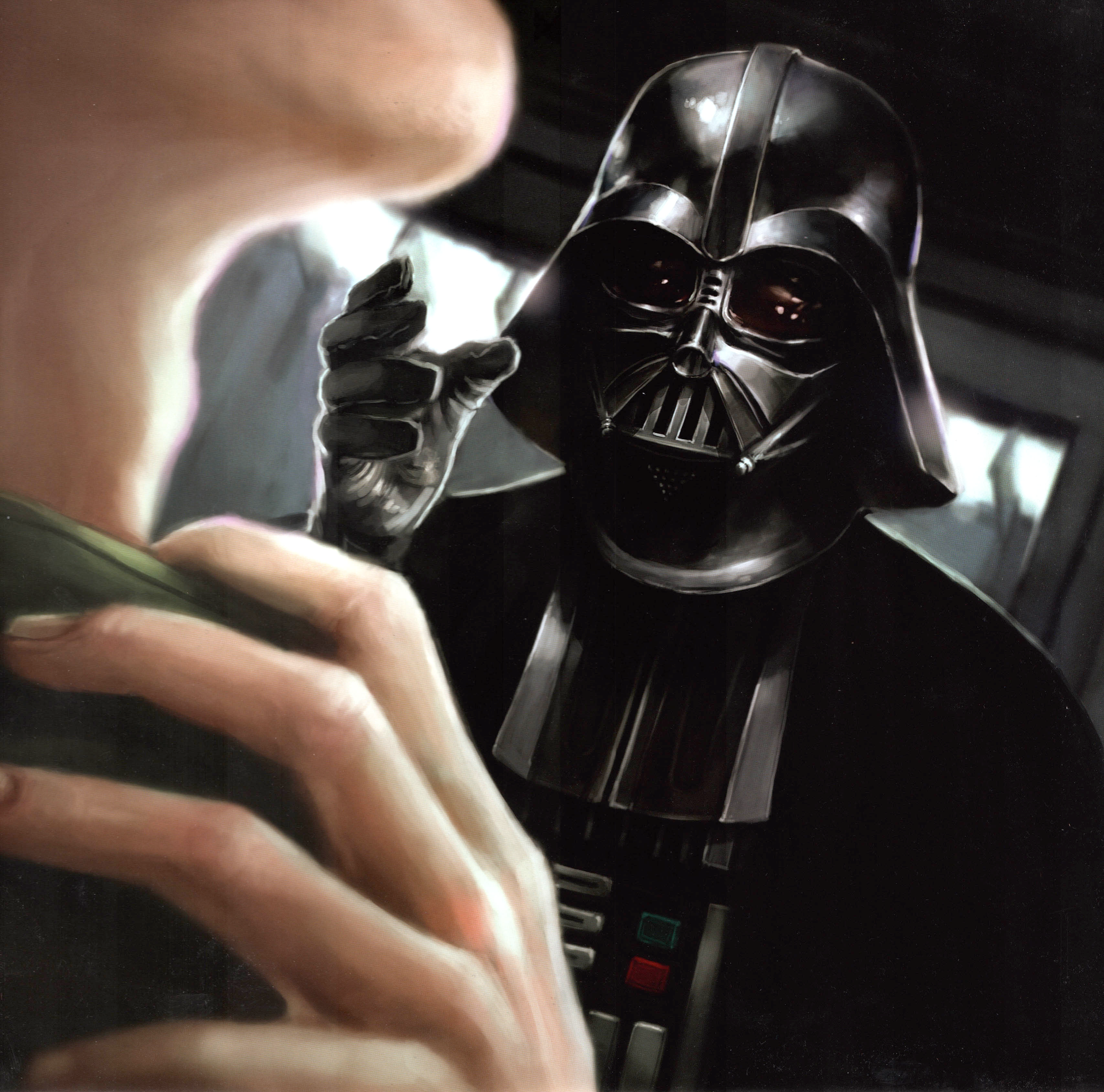
This telekinetic ability, primarily offensive in nature, involved gripping or constricting the throat or trachea of a living being. At lower intensities, it effectively choked or strangled the target. Force Choke could also be used to exert physical force on the target's neck, allowing the user to grasp and hold them without physical contact. By applying sufficient pressure, a user could potentially crush the victim's throat or even fracture their neck and vertebrae. Sith Masters often employed this technique to punish individuals, enforce obedience, or demonstrate their power. Those affected typically clutched at their throats. While more commonly associated with the Sith, it was also utilized by Jedi on occasion.
Perhaps the most iconic demonstration of this ability was by Darth Vader aboard the Death Star. When Admiral Conan Antonio Motti expressed skepticism towards the Dark Lord's "sorcerer's ways," Vader responded by Force Choking him, stating, "I find your lack of faith disturbing." listen (help·info)
In most cases, a live visual of the victim was sufficient to execute the technique. Darth Vader demonstrated this by choking Admiral Kendal Ozzel across a viewscreen, even though the admiral was on the bridge while Vader was in his meditation chamber. However, this ability required intense focus; any lapse in concentration would break the choke and restore the target's freedom of movement. Some individuals possessed sufficient power and experience to kill someone via Force Choke without any visual contact. Examples include Barriss Offee, who killed Letta Turmond and framed Ahsoka Tano, and Darth Sidious, who eliminated the Shadow Collective guards before confronting Darth Maul and Savage Opress. Darth Vader was also seen using this ability to express his displeasure with an Imperial officer during one of his Jedi hunts, choking the man while pointedly looking away. Shortly thereafter, he similarly broke Kento Marek's neck via a Force Grip while averting his gaze. Emperor Palpatine could also remotely choke targets, as when he punished Admiral Termo for speaking out of turn during a hologram communication.
Darth Vader was indeed one of the most notorious users of this Force technique, frequently choking those who displeased or failed him, providing a clear and forceful demonstration of the Force to any skeptics witnessing the grim spectacle. Anakin Skywalker, upon his transformation into Darth Vader and his descent to the dark side, used Force Choke on his pregnant wife, Padmé Amidala, after accusing her of bringing Obi-Wan Kenobi to Mustafar to kill him.
This was not his first instance of using the technique. Early in the Clone Wars, he had used the Force to choke Jabiimi Loyalist Orliss Gillmunn at the conclusion of the Battle of Jabiim. Later in the same conflict, Skywalker used this technique to torture Separatist leader Poggle the Lesser after the Second Battle of Geonosis. After Obi-Wan Kenobi's unsuccessful attempts to extract information from the Separatist leader, Anakin lost his temper when Poggle refused to provide vital intelligence that could save Ahsoka Tano and Barriss Offee from the brain worms. He would also later use it on Asajj Ventress while interrogating her about who had framed his apprentice, and on the Zygerrian queen, Miraj Scintel, after she threatened his master and apprentice with death if he did not obey her. During the Banking Clan investigation, he again used Force choke on Rush Clovis during an anger-fueled hand-to-hand brawl in Padmé Amidala's apartment.
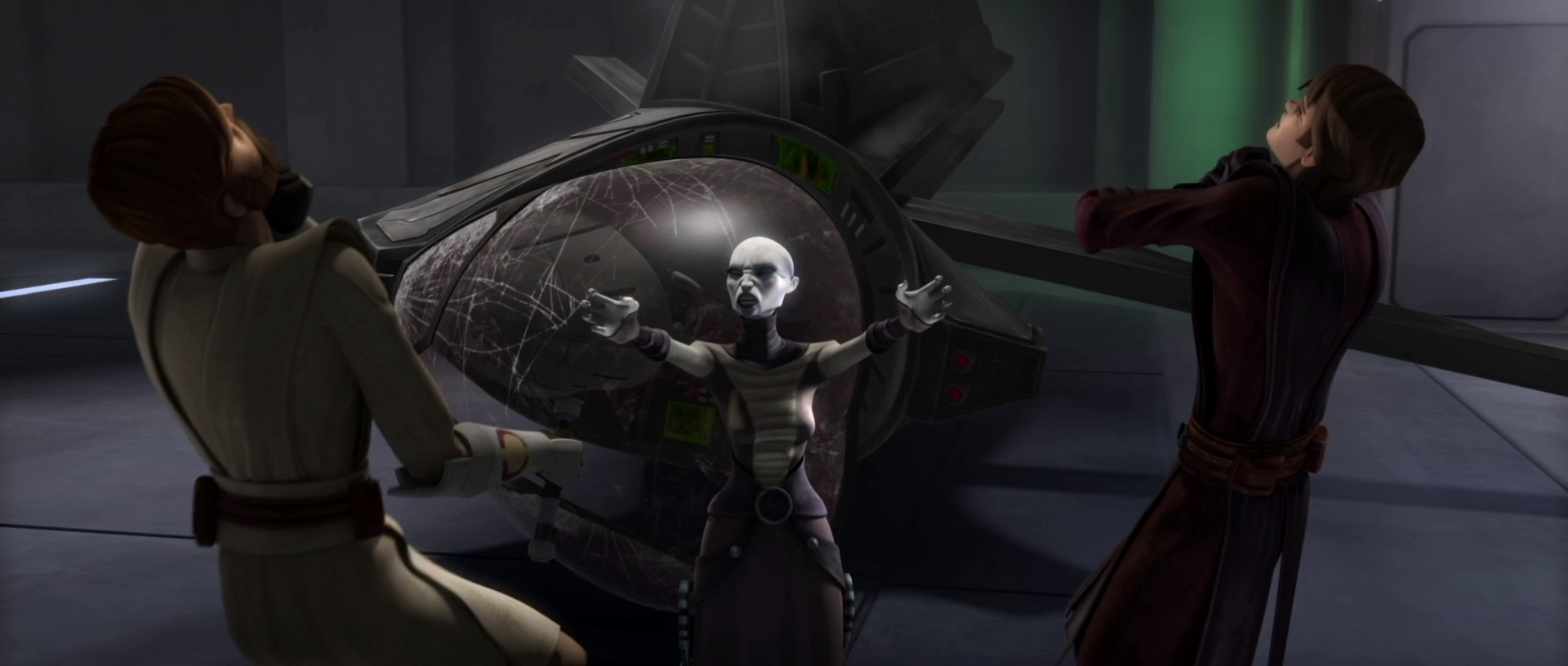
Other Force users known to have employed this power included Darth Revan, who was seen choking a Republic soldier aboard his flagship. Darth Tyranus choked his former apprentice, Komari Vosa, after she was defeated by a bounty hunter.
In the aftermath of the Great Sith War, a Bimm later known as Toki Tollivar, embarked on a prolonged campaign of serial killings. He murdered all of his victims by choking them with the Force, leading to bounties being issued from Corellia for the "Corellian Strangler." He was eventually discovered by Zayne Carrick aboard the Chancellor Fillorean and killed by Demagol.
Although dark side users reveled in employing this power, particularly for humiliation, it was also used by those aligned with the light side. One of the most famous Jedi to use Force Choke after the Great Jedi Purge was Luke Skywalker, who used it against Gamorrean guards while gaining entry to Jabba's Palace. Luke also used it on one of the Nightsisters. In both instances, he used the ability to incapacitate his opponents, not to kill them. In 40 ABY, Jacen Solo used this technique against a female Hapan officer who questioned his authority, releasing her afterward. He also Force-choked Patra Tebut for disobeying orders, this time with lethal consequences. Kueller used Force choke on Femon. Gorc would hold a victim stationary while his "brother" Picaroon C. Boodle attacked; Maw delighted in his enemies' suffering. The Jedi Exile could also use the power regardless of alignment.
In 3 ABY, during a mission to the ice planet of Hoth, Lord Starkiller used Force choke on Captain Keenah while communicating with him over an intercom as he fought his way through a collapsing Wampa-infested ice cavern. Starkiller did not require visual contact with Keenah to use this ability.
This power was used to telekinetically destroy a victim's organs. On Korriban, Darth Tyranus used Force kill to destroy the heart of the black-market dealer Auben, killing her instantly. Darth Bane also used Force kill on his father by visualizing a giant hand squeezing his father's heart, resulting in a fatal heart attack. A similar technique was Heart stun, which halted the heart and, if used correctly, could induce a state of stasis.
Darth Vader possessed the knowledge and ability to stop a victim's heart or freeze their lungs using the Force, a power he also demonstrated as a Jedi.
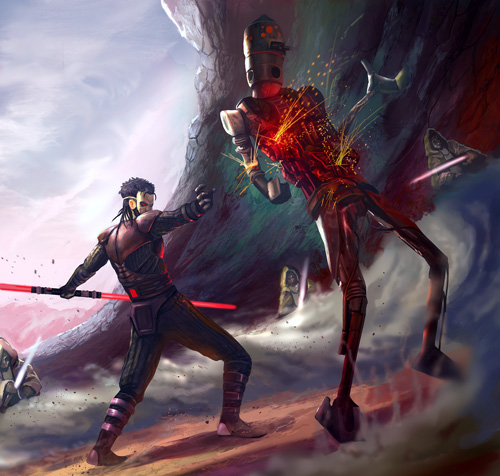
This deadly technique, one of the most violent Force abilities known to both the Sith and the Jedi, involved lifting an opponent into the air and then crushing their body inward until it imploded.
Obi-Wan Kenobi used this technique on two commando droids on Kadavo to retrieve his lightsaber after battling the Zygerrian Darts D'Nar and giving Anakin Skywalker time to destroy the bombs around the city.
Late in the Clone Wars, Mace Windu used Force Crush on General Grievous as the cyborg attempted to transfer his "captive" Palpatine to the Invisible Hand, crushing his lungs, one of the few organs he had left. This contributed to his constant choking and coughing for the remainder of his life. While his lungs could have been repaired surgically, he did not survive long enough to receive the treatment. This instance of a Jedi using the technique on a living being was rare, as most Jedi considered the technique too violent and aligned with the dark side.
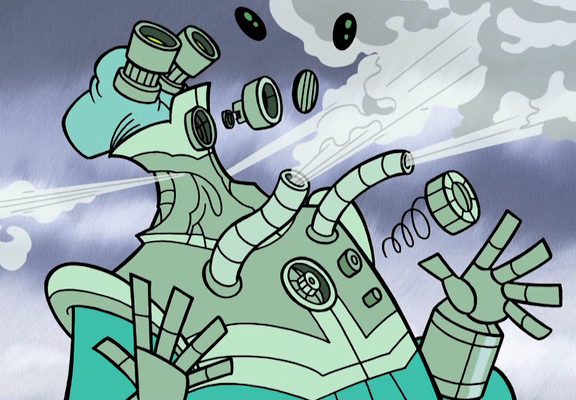
Darth Vader, who readily employed Force Crush and similar techniques on Imperial personnel he deemed incompetent, was capable of crushing small vehicles on the battlefield. Even during the Clone Wars, Anakin Skywalker demonstrated this power on Nelvaan when he used it to crush the Techno Union scientist before he could escape.
Although the Horn family was generally deficient in telekinesis, Nejaa Halcyon was able to employ Force Crush against Nikkos Tyris after absorbing energy from Anzat's lightsaber. Darth Traya also used this powerful attack to compensate for her age and lack of physical strength, making it an effective display of her power. Darth Bane was also a notable practitioner, as seen when he crushed Qordis on Ruusan.
Galen Marek was also known to use this ability against an AT-ST on Raxus Prime during his assault on the Imperial factory.
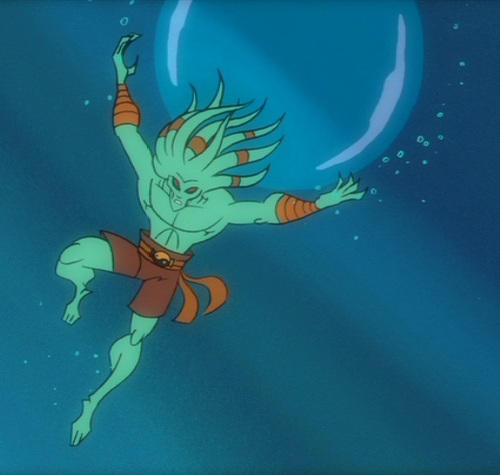
Force Orb involved generating a sphere of pure Force energy that displaced the surrounding environment, creating a bubble of air. Typically, this ability was only effective underwater. Kit Fisto employed it during the Battle of Mon Calamari, creating a ball of air underwater to disable a crab cannon. During the Battle of Mon Cala, Kit Fisto and Anakin Skywalker attempted to use this power to create a makeshift air helmet for Padmé Amidala after Riff Tamson spitefully broke her helmet with his jaws. While they succeeded, Jar Jar Binks's Gungan saliva proved to be a more effective sealant.
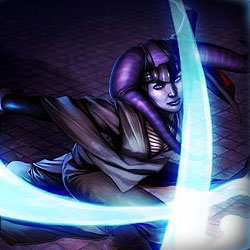
A defensive maneuver, the saber barrier was a telekinetic lightsaber combat technique utilized by some practitioners of dual-saber combat within Luke Skywalker's New Jedi Order. It involved levitating the lightsabers and whirling them in a horizontal circle around the Jedi, creating a defensive yet deadly wall of lightsaber blades, primarily effective against melee attacks.
Jedi Master Mace Windu was a practitioner of saber barrier, as were the Dark Jedi Alora and several New Reborn. Jaden Korr may have also mastered this technique. Darth Traya employed a variant of this power in her final confrontation with Meetra Surik, summoning three violet lightsabers to fight on her behalf.


This technique represented an offensive application of the lightsaber. By either manually locking the blade in the 'on' position or using the Force to hold the activation button, the Force user could throw the lightsaber in a boomerang-like fashion, allowing it to cut through obstacles and, typically after deactivation, return to the caster's hand. Variations in user skill allowed some to hurl their lightsabers over great distances, make mid-air course corrections, or keep them hovering in place. These refined techniques could be combined to enable telekinetic lightsaber combat.
Additionally, a destructive variation of the technique existed where the saber could be thrown directly at the target.
This was extremely dangerous to living beings, particularly if it struck vital areas such as the heart or head. Galen Marek was a skilled practitioner of this ability. His clone was also proficient, often throwing both of his weapons simultaneously into troop formations with devastating results.
The skill has also been used by Savage Opress and later Yoda, Darth Vader, Kyle Katarn, and Jaden Korr. Darth Revan and Meetra Surik may have also possessed this power.
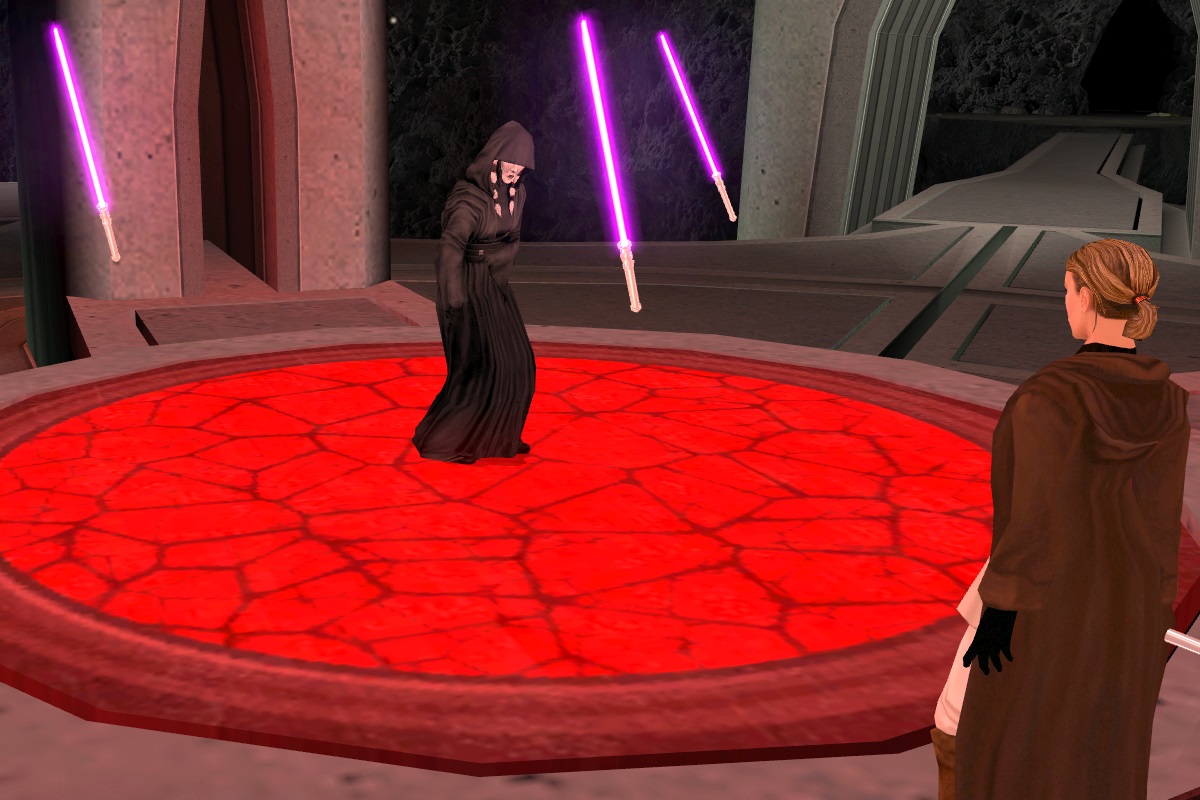
Telekinetic lightsaber combat techniques involved the use of telekinesis in lightsaber combat. Some, like Saber Throw, were offensive, while others were defensive.
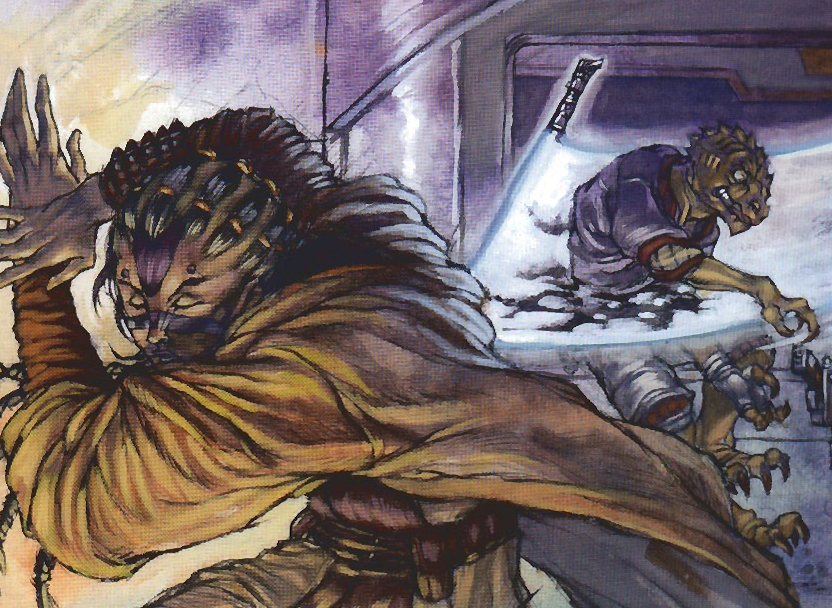
Darth Traya demonstrated the most remarkable form of telekinetic lightsaber combat—the ability to wield at least three lightsabers independently in combat, holding each aloft with the Force and allowing them to fight with a will of their own.
The Reborn Revan utilized a similar technique during his fight with the strike team on Yavin 4 inside the Temple of Sacrifice, using both his backup lightsaber and the blade of his former friend, Malak, to combat his opponents multiple times during the confrontation; however, they were easily knocked down into the center of the chamber or over the edge several times before his retreat from the temple.
Darth Bane demonstrated this ability when he telekinetically used his lightsaber to kill three young boys while their father helplessly watched. Millennia later, Mace Windu would use the ability during the Battle of Coruscant. Though brief, his skill with the Force allowed him to unclip his weapon from his belt and activate it, destroying a Super battle droid with one swift stroke. The cloned Starkiller was capable of using this ability to attack whenever he was empowered through Force rage.
Designated as Flamusfracta within High Galactic, combustion was a sophisticated Force ability of telekinetic nature. It empowered its practitioners to detonate objects using only their willpower. Seldom directed at living beings, combustion's impact on both objects and individuals was catastrophic. Successful application hinged on the object's dimensions, density, and resistance to damage; larger, denser, or more resilient objects were harder to explode. A single blast's force could inflict harm upon multiple adversaries within a confined space, especially if the targeted object was flammable. Debate persists regarding the possibility of countering or halting combustion through the focused concentration of another Force user attempting to shield the object from detonation. The effectiveness of such a countermeasure remains uncertain, with outcomes ranging from complete nullification to utter failure.
The employment of this power is attributed to Yarael Poof.
In The Jedi Path: A Manual for Students of the Force, Darth Sidious dismissed this ability as "mere child's play". Following his revival on Byss, Palpatine utilized combustion to trigger the explosion of a 10,000 year old lightsaber within the grasp of Leia.
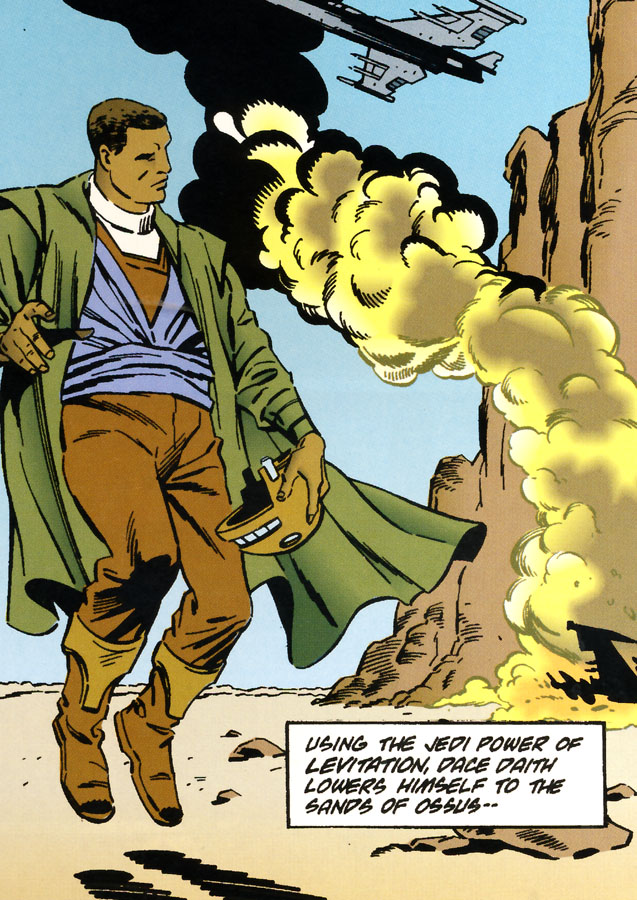
Jedi levitation was a Force-based technique that enabled individuals to defy gravity and float. This skill did not require physical contact. By employing the Force, practitioners could suspend themselves in the air and navigate as desired. Adept and potent Force users could temporarily overcome gravity, inertia, friction, and other physical constraints to enhance their movement, even to the extent of gliding.
During his retraining at the Jedi academy on Dantooine, Revan briefly employed levitation to deepen his connection with the Force.
During the Galactic War, specifically during a Kaggath on Corellia, Darth Thanaton used this power to evade the future Darth Nox.
During their Duel on Balowa, Kaox Krul and Crian Maru levitated themselves above a lake as they fought.
After surviving the crash of his Star Saber XC-01 starfighter, Jedi Knight Dace Diath employed levitation to carefully descend to the surface of Ossus.
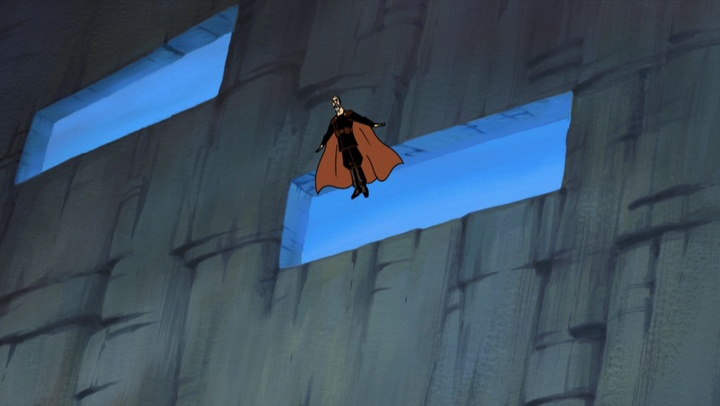
Force Flight was a Force technique that allowed a user to propel themselves towards a chosen point via telekinesis, representing an advanced application of levitation (as described above). Mastery of this Force power demanded considerable focus.
Maw, a Dark Jedi, exhibited proficiency in this ability. After Qu Rahn severed his lower body, Maw initially relied on a repulsorlift for mobility. However, he eventually mastered Force Flight to the point of instinctive use. Darth Tyranus, Darth Vader, and Darth Sidious may have also demonstrated this power through their ability to hover in standard gravity conditions. The Dark Jedi Yun might have also possessed this ability to some extent. His master, Jerec, also showcased this power within the Valley of the Jedi. Luke Skywalker could employ this ability in low-gravity environments. His wife had also acquired this skill by 40 ABY. The ancient Sith Lord Darth Thanaton also demonstrated the capacity to levitate via the Force, exhibiting sufficient control to achieve true flight. Ganner Rhysode once told Corran Horn that he could levitate them both for almost a kilometer, but it would be extremely energy-intensive. It's possible Force Flight was related to Floating Meditation, a meditative technique where the practitioner hovered a few inches above the ground. Certain Dathomiri witches, Lord Nyax, Mara Jade, and Darth Venamis also used this power. Furthermore, it was easier to use in low gravity, as demonstrated by Ben Skywalker and his father during Luke's exile, leading to Luke's subsequent claim that he couldn't fly. Additionally, Darth Sidious could use the Force to float within a shell of lightning, though it remains unclear if this is the same power.
An ancient Sith technique. This power allowed a Force user to manipulate air currents, creating a potent and devastating tornado capable of lifting and hurling targets.
During his training on Yavin 4, Streen used this power to levitate the comatose Luke Skywalker after being deceived by the spirit of Exar Kun. He also employed it during the attack on Yavin 4 in 12 ABY to neutralize incoming TIE fighters, destroying four by colliding them with each other.
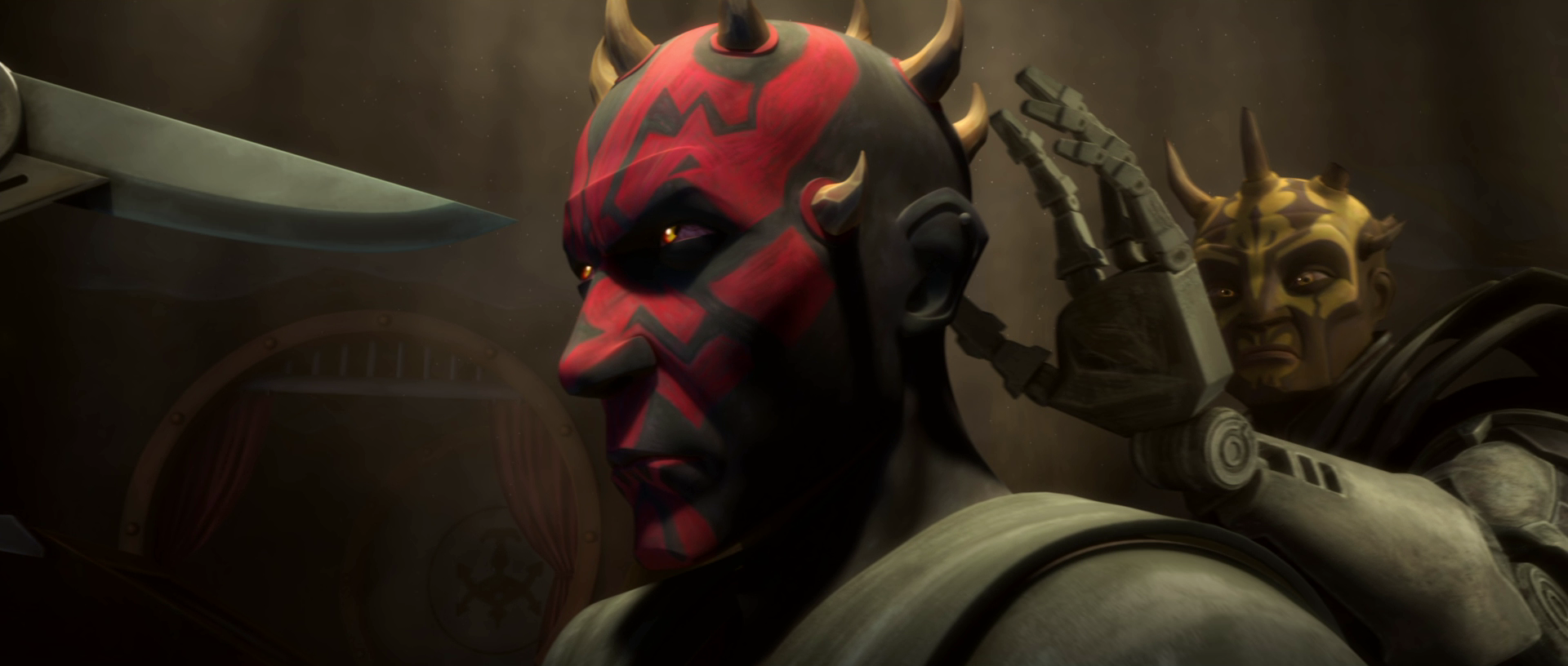
Projected fighting was a telekinetic application used to inflict harm without physical contact. The extent of damage depended on the attacker's physical strength, with the power acting as an extension of their physical capabilities in close combat. Users could also modulate their strength to stun rather than injure. Targets could defend against projected fighting as they would against a standard hand-to-hand attack, or, if Force-sensitive, by using the Force.
Proficiency in unarmed combat and sheer physical power enhanced the effectiveness of projected fighting techniques. The power could target any opponent within the attacker's line of sight and was easier to apply against closer adversaries.
Specific methods included telekinetically projecting dirt, dust, and debris to impair an opponent's vision. One could also interpose a small object to deflect an incoming projectile.
Similar techniques encompassed Force punch, Force kick, and Shadowstrike.

Before renouncing his commission, Count Dooku recorded telekinesis teachings on the Holocron of Asli Krimsan. These recordings became required viewing for two generations of Jedi apprentices.
During Luke Skywalker's training on Dagobah, Yoda explained that an object's size and weight were merely mental constructs. Once these perceptions were overcome, objects of any size could be manipulated. Yoda demonstrated this by lifting Luke's X-wing from the swamp.
Anakin Skywalker used telekinesis to lift and cut a piece of fruit for Padmé Amidala, returning a portion to her.
Revan employed telekinesis to lift and move several objects, including two chairs and a datapad, in a circular motion while simultaneously levitating himself using Floating Meditation at the Jedi academy on Dantooine.
Kyle Katarn used it to support a collapsing rock wall after Jaden Korr fought Rosh Penin and Tavion Axmis, enabling Korr to use Katarn's lightsaber to cut them to safety.
Rahm Kota used telekinesis to detach a section of a TIE fighter factory and hurl it into the atmosphere of Nar Shaddaa while still inside.
Jedi Master Corran Horn was notably weak in telekinesis, a recurring trait in his family's Jedi lineage.
Darth Traya used telekinesis to wield three lightsabers concurrently after Meetra Surik severed her remaining hand.
Mace Windu used it to hurl a vibro-ax in his final duel with Kar Vastor, dismembering his opponent. Count Dooku used it during his battle against Master Yoda on Geonosis, and again while dueling Obi-Wan Kenobi and Anakin Skywalker aboard the Invisible Hand. Palpatine used it against Master Yoda in his battle in the Senate Building, and much later used it to unlock Luke Skywalker's restraints aboard the Death Star. Kreia used it while battling against Meetra Surik. Carnor Jax, a former member of the Emperor's Royal Guard and aspiring Sith Lord, possessed some telekinetic abilities.
The Zeison Sha were among the most skilled telekinetic practitioners. Neither Jedi nor Sith, their mastery of telekinesis developed over decades of surviving the harsh environment of their planet, Yanibar, exceeding even some of the most powerful Jedi. Their preferred weapon was a discblade, a circular, bladed weapon thrown and controlled with the Force, requiring significant telekinetic skill to wield effectively.
Darth Vader's valet also possessed telekinesis, a power said to be inherent to his species. It remains unclear whether this was a manifestation of Force-sensitivity or another supernatural talent.
Similarly, certain other species, such as Mind-witches, possessed telekinetic abilities that may or may not have been Force-related.
There were several impressive displays of telekinesis. Dorsk 81, channeling the combined Force of all available Jedi at Luke Skywalker's Jedi Praxeum, used telekinesis to push seventeen Imperial I-class Star Destroyers out of the Yavin system. The immense Force expenditure cost the Jedi his life.
Another extreme display of telekinesis was accomplished by Darth Nihilus. He used the power to extract a Centurion-class battlecruiser from the massive artificial gravity well created by the Mass Shadow Generator around Malachor V, a gravity well so intense it nearly destroyed the planet.
During the Yuuzhan Vong War, Jedi Master Kyp Durron moved a black hole back onto the ship projecting it, bypassing the Yuuzhan Vongs' near immunity to the Force and annihilating the vessel. This was inspired by a similar attack used by the leader of the New Jedi Order some time before.
To streamline gameplay, the Wizards of the Coast Star Wars Roleplaying Game renamed many similar uses of telekinesis to "Move object," also known as "Object manipulation." This generally included Force Jump, Fall, Push, and Pull. Force strike/push and grip/choke were the only other telekinetic attacks. Otherwise, the skill was vaguely referred to as Object manipulation or "Alter."
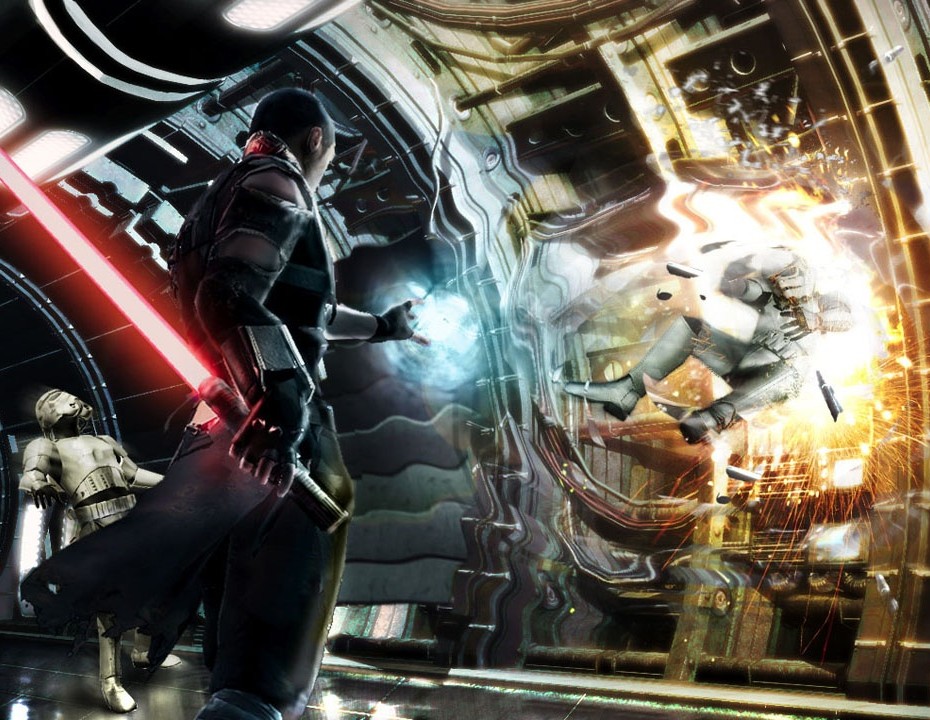
In the Star Wars Roleplaying game, "Force Push" served as the standard telekinetic offensive for trained Force users. In the revised version, "Force Strike" represented the use of the Force to "strike" a target, dealing damage akin to a punch rather than a push. Until Jedi Counseling 60, using Force Strike on a living target (as opposed to a droid or inanimate object) was considered an act of the dark side. This error was corrected in subsequent books. "Force Push" became a variant of this, in which the opponent is knocked down or thrown aside in the more familiar way.
As one of the few offensive powers not inherently dark, Force Push often formed the basis of a Jedi's offensive capabilities.
In Star Wars: Knights of the Old Republic and its sequel, Force Push had three levels. The first was the conventional Force Push, which knocked an opponent back; the second was Force Whirlwind, which lifted the opponent from the ground and created a whirlwind around them; the last was similar to the first, but affected a much wider area in front of the player.

An exception to the requirement of maintaining visual sight when using a Force Grip occurred in the novel Darth Bane: Path of Destruction, where Lord Hoth gripped a Sith Warrior who nearly fell on him during an attack, holding her in midair until one of her allies inadvertently killed her, while Lord Hoth was staring in the opposite direction.
The most powerful user of this ability was Anakin Skywalker in the non-canon story "What if the father never rescued Anakin from the Dark Side?" in Star Wars: The Clone Wars Magazine 7. In a duel against Yoda and Darth Sidious, Anakin conjured a Force Whirlwind so strong that it evolved into a hurricane, destroying much of the Senate Building.
It had the power to destroy an entire droid squadron. Mace Windu demonstrated this at the Battle of Dantooine, when he was without his lightsaber.
Darth Vader appeared to use a very powerful Force Wave in the computer game Star Wars: Empire at War, not only pushing enemies a great distance but also killing them.
In the Revenge of the Sith game, Obi-Wan and Anakin used a Force Wave to clear a path for them to escape battle droids aboard the Invisible Hand.
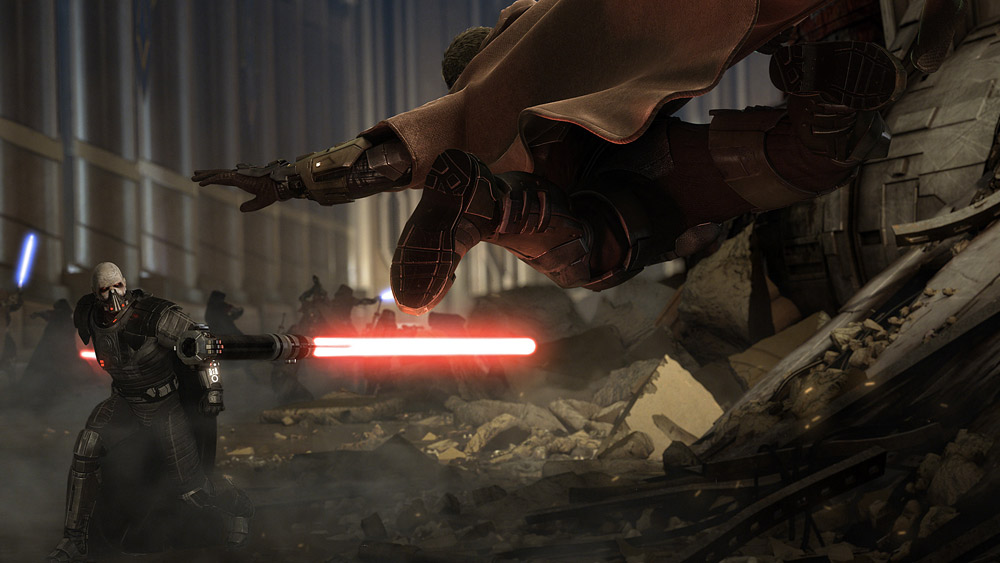
Saber throw appears only three times in the six live-action movies, yet is relatively common in video games and animated media. This is likely due to the desire to add a ranged dimension to lightsabers, which are more often considered melee weapons. In the movies, Dooku used saber throw against Yoda in Attack of the Clones (visible only in a few frames) as Yoda leaped on surfaces to avoid the Sith's blows, Yoda used it against a 501st Legion clone trooper in Revenge of the Sith, and Darth Vader used it against Luke Skywalker in Return of the Jedi.
The saber barrier technique was introduced in Star Wars: Episode I Jedi Power Battles as Mace Windu's special power.
While the player's character cannot move while executing this move, non-player characters can "jump out" from the barrier.
The technique is named on Star Wars: Jedi Knight: Jedi Academy, and in the 'datapad' in-game.
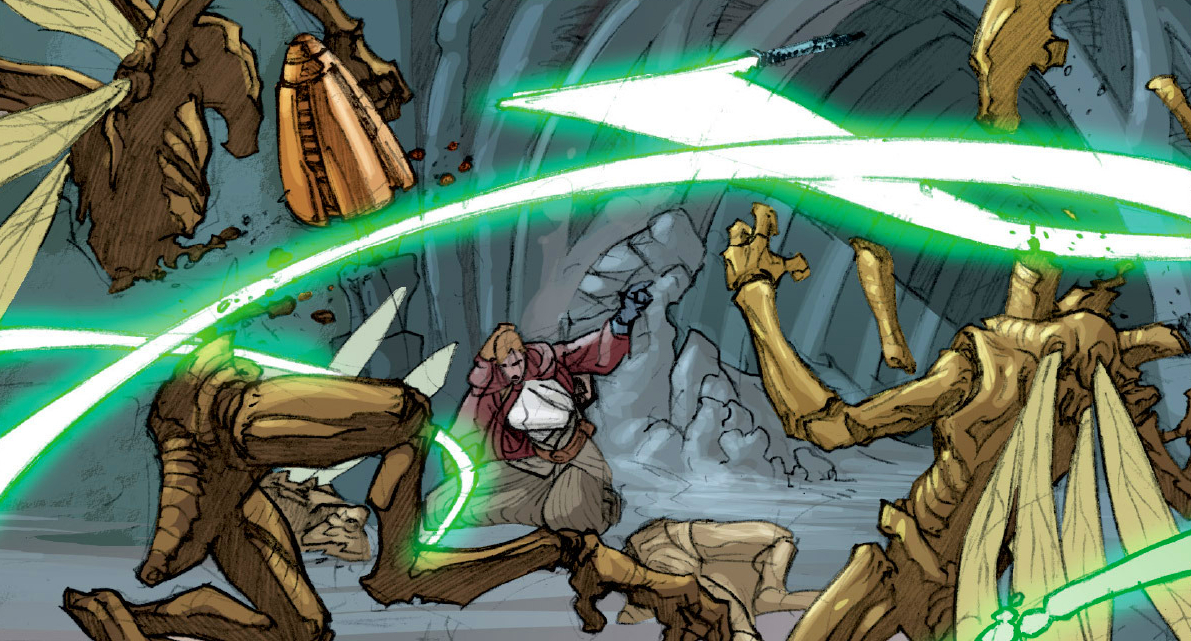
Many fans argue that most examples of this are not true "flight" but merely slowed movement during a fall or added power to the legs during a jump. The determining factor should be the actual movement involved: falling (Dooku's floating, Kenobi and Skywalker falling great distances), leaps (Mace Windu on Dantooine), or hovering (the Witches of Dathomir). With the exception of some witches of Dathomir, Lord Nyax, Mara Jade, Ben Skywalker and his father, Darth Venamis, and specific instances in Battlefront, almost all other uses were some variation of moving an object, including oneself. Additionally, it may be easier to use this technique while in low gravity, as shown when Luke and Ben used this technique during Luke's exile, leading to Luke's subsequent claim that he couldn't fly. Moreover, Darth Sidious could use the Force to float within a shell of lightning, though it remains unclear if this is the same power.
Force flight was also mentioned in the 2001 Dark Side Sourcebook by Wizards of the Coast as an ability possessed by the Witches of Dathomir. That talent has since been redesigned to afford movement for a brief period of time, but not prolonged flight, in the Saga edition ruleset.
Some assert that Mace Windu exercised the Force flight power in "Chapter 13" of the Clone Wars cartoon series; however, this has not been confirmed and can be interpreted as an extreme demonstration of Windu's skill in telekinetically moving himself and droids quickly and over great distances.
Morag, the Tulgah sorceress, was able to fly in the comic Ewoks 12. This ability is shown on the front cover and several pages inside. Wicket even says, "Look, Morag is flying to the brush." Morag's powers are attributed to magic; however, the Hyperspace article "Castaways of Endor" claims that all magic shown in Star Wars: Ewoks is, in fact, performed through the use of the Force.
